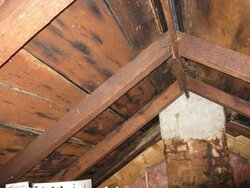Hi all...
I think this has been discussed before but I cant find too much with search so...
Anyway I posted in other threads about the massive insulation and air sealing upgrade we did this year - densepack cellulose in our walls, ceilings and sloped roof, rigid foam on the kneewalls etc. So far its made a big difference on the bills and judging by the lack of snow melt looks like its going to fix the ice damming in front.
Problem is, snow is still meting on the back addition roof over the small attic. Right now there is not enough snow to cause and issue but it tells me I'm still putting too much heat into that attic. It is well ventilated. Spending some time in there with the IR temp gun I think the issue is the chimney for the stove which passes through this attic. Its a full steel liner running inside the masonry flue but it still wams it. Temp gun reads the outside of the brick at 72F while the stove is cranking. Floor to the room below reads about 45-50.
So I think this warm chimney is the culprit.
I'm thinking I should wrap it in insulation, and see if that makes a difference. I believe its code legal to wrap it in Roxul, correct?
Just looking for thoughts from the experts before I do this...
I think this has been discussed before but I cant find too much with search so...
Anyway I posted in other threads about the massive insulation and air sealing upgrade we did this year - densepack cellulose in our walls, ceilings and sloped roof, rigid foam on the kneewalls etc. So far its made a big difference on the bills and judging by the lack of snow melt looks like its going to fix the ice damming in front.
Problem is, snow is still meting on the back addition roof over the small attic. Right now there is not enough snow to cause and issue but it tells me I'm still putting too much heat into that attic. It is well ventilated. Spending some time in there with the IR temp gun I think the issue is the chimney for the stove which passes through this attic. Its a full steel liner running inside the masonry flue but it still wams it. Temp gun reads the outside of the brick at 72F while the stove is cranking. Floor to the room below reads about 45-50.
So I think this warm chimney is the culprit.
I'm thinking I should wrap it in insulation, and see if that makes a difference. I believe its code legal to wrap it in Roxul, correct?
Just looking for thoughts from the experts before I do this...


